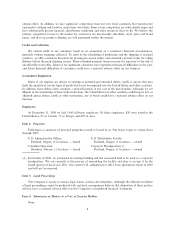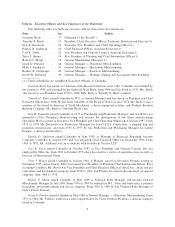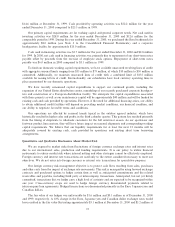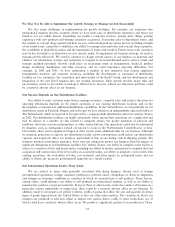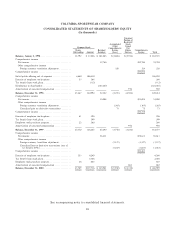Columbia Sportswear 2000 Annual Report Download - page 29
Download and view the complete annual report
Please find page 29 of the 2000 Columbia Sportswear annual report below. You can navigate through the pages in the report by either clicking on the pages listed below, or by using the keyword search tool below to find specific information within the annual report.decline, when there is an economic downturn or economic uncertainty in our key markets, particularly markets
in North America and Europe. Continuing weakness in the Japanese economy, for example, has limited
growth opportunities in recent years, and a slowing economy in the United States in 2001 has created
additional uncertainties for our business. Our sensitivity to economic cyclicality and any related Öuctuation in
consumer demand could have a material adverse aÅect on our results of operations and Ñnancial condition.
We Are AÅected by the Financial Health of Retailers
We extend credit to our customers based on an assessment of a customer's Ñnancial circumstances,
generally without requiring collateral. To assist in the scheduling of production and the shipping of seasonal
products, we oÅer customers discounts for placing pre-season orders and extended payment terms for taking
delivery before the peak shipping season. These extended payment terms increase our exposure to the risk of
uncollectible receivables. In addition, we face increased risk of order reduction or cancellation when dealing
with Ñnancially ailing retailers. Some of our signiÑcant customers have experienced Ñnancial diÇculties in the
past, which in turn have had an adverse aÅect on our business. A slowing economy in our key markets could
have an adverse aÅect on the Ñnancial health of our customers, and therefore create additional risks for our
business.
We Operate in Very Competitive Markets
The markets for outerwear, sportswear and rugged footwear are highly competitive. In each of our
geographic markets, we face signiÑcant competition from global and regional branded apparel and footwear
companies. In many instances, retailers who are our customers pose a signiÑcant competitive threat by
marketing apparel and footwear under their own labels. We also compete with other apparel and footwear
companies for the production capacity of independent manufacturers that produce our apparel and for import
quota capacity. Many of our competitors are signiÑcantly larger and have substantially greater Ñnancial,
distribution, marketing and other resources and have achieved greater recognition for their products than we
have. Increased competition could result in reductions in display areas in retail locations, reductions in sales or
reductions in prices of our products, any of which could have a material adverse aÅect on our business.
We Face Risks Associated with Consumer Preferences and Fashion Trends
We believe we have beneÑted from changing consumer preferences, including increased consumer
interest in outdoor activities and lifestyle changes that emphasize apparel designed for these activities.
Changes in consumer preferences or consumer interest in outdoor activities could have a material adverse
aÅect on our business. In addition, although we believe our products have not been signiÑcantly aÅected by
past fashion trends, changes in fashion trends could have a greater impact as we expand our oÅerings to
include more product categories. Also, we face risks because our business requires us to anticipate consumer
preferences. Our decisions about product designs often are made in advance of consumer acceptance.
Although we try to manage our inventory risk through early order commitments by retailers, we must
generally place production orders with manufacturers before we have received all of a season's orders. If we
fail to anticipate accurately and respond to consumer preferences, this could lead to, among other things, lower
sales, excess inventories and lower margins.
Our Business is AÅected by Weather Conditions
Sales of our outerwear are dependent in part on the weather and may decline in years in which weather
conditions do not favor the use of our outerwear. For example, we believe unseasonably warm weather in the
United States in 1998 and 1999 caused customers to delay, and in some cases reduce or cancel, orders for our
outerwear, which had an adverse eÅect on the our net sales and proÑtability. Periods of unseasonably warm
weather could have a material adverse eÅect on our business.
17



